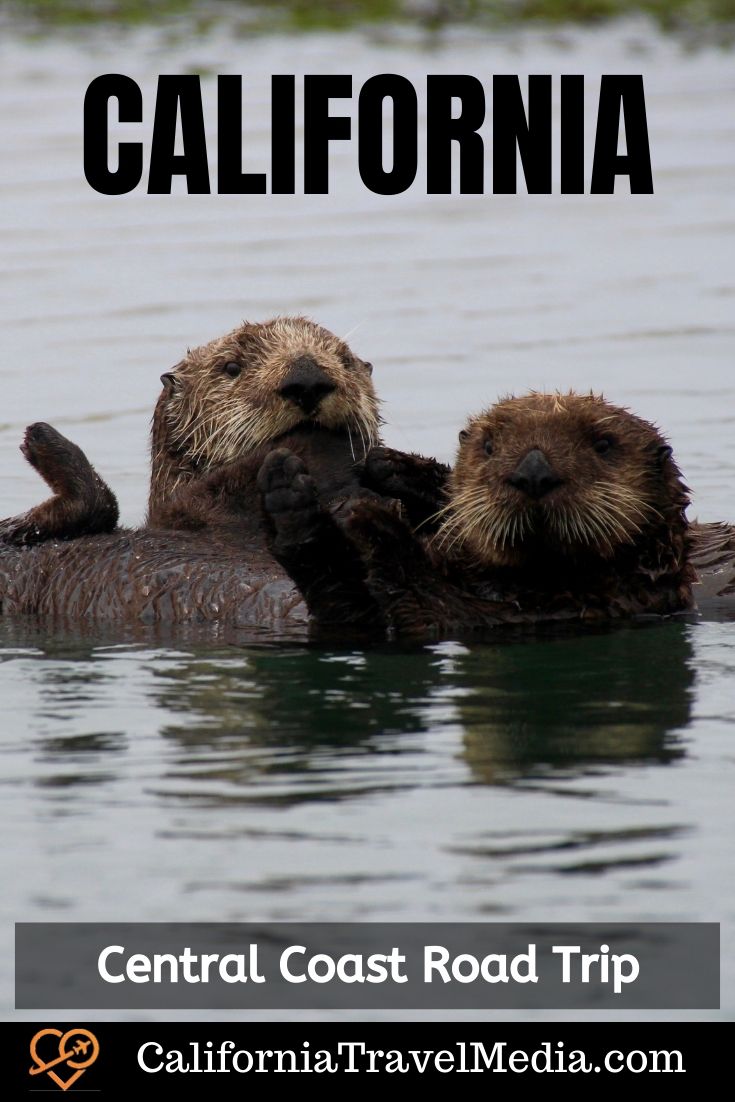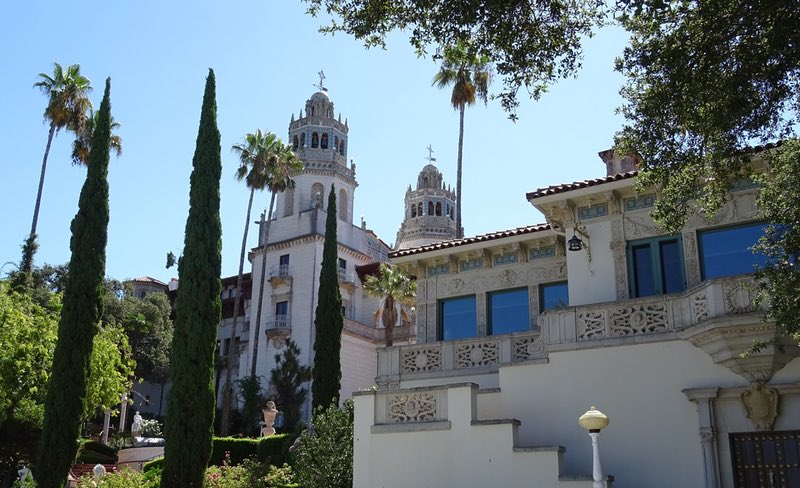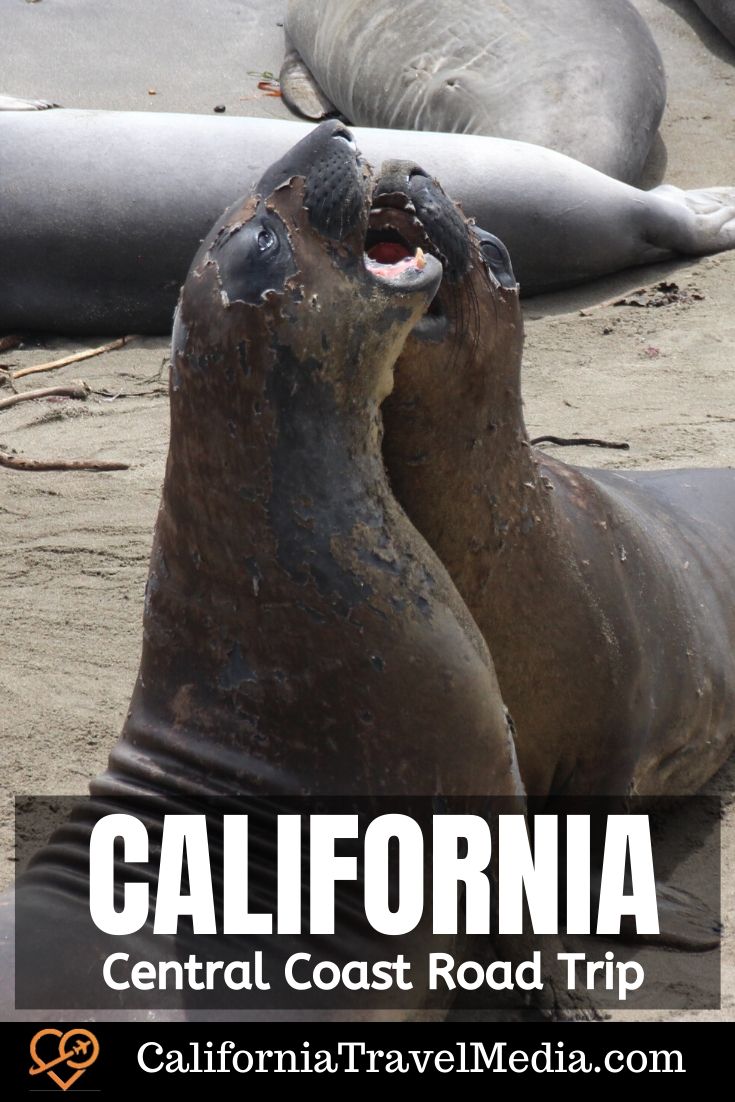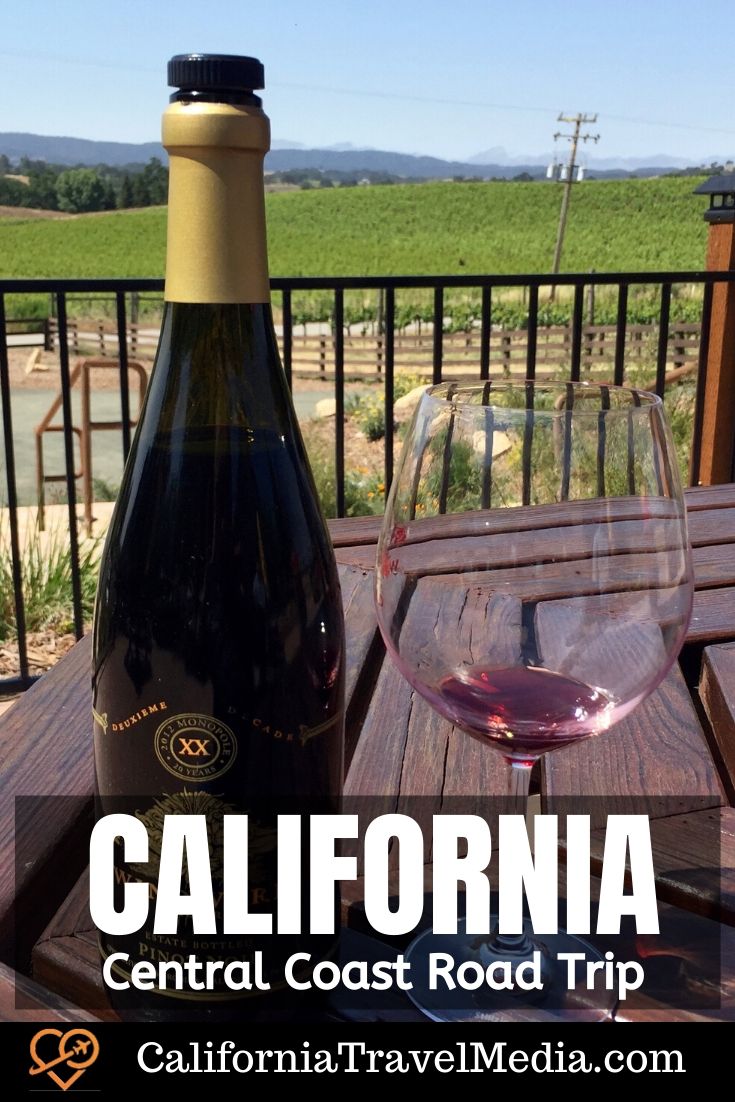Things to do on a Central Coast of California Road Trip – Pinnacles, Parks, Pinot, and Paddling
categories: Central CoastCalifornia is, in my opinion, one of the best states in the United States for a road trip. It is the scenery, the wildlife, and, of course, the wine. One of the best of these road trips is California’s Highway 1 by Big Sur.
Back in 2010, I had the opportunity to explore the North Island of New Zealand in a converted minivan that was turned into an RV. One of the companies, Jucy RV, which popularized those in New Zealand, has now come to my backyard in California. I recently had a chance to do a road trip to the California Central Coast, where I grew up, in one of their RVs. Let me introduce you to some of my favorite things to do on the Central Coast of California, including a road trip up California’s Highway 1.

Table of contents: ()

Central Coast California Map
Pinnacles National Park
The central coast of California has changed a lot since I grew up there (what without all the dinosaurs). One of the cool changes is that my home county, Monterey County, now has a National Park, Pinnacles National Park. Pinnacles was a National Monument but recently got an upgrade. If you’re not familiar with the park, it is a collapsed ancient volcano in one of California’s coastal ranges.
It’s a great place to hike and so that’s just what I did. I met JD from the Monterey tourism board for a hike from the west entrance of Pinnacles. I had never been to the west entrance of the park before, it’s winding one-lane road is a great argument for why driving an RV no bigger than a minivan is a joy. This is not a road for a movable house.

We hiked the Balconies Cliffs – Balconies Cave Loop (2.4-mile loop). In Pinnacles, even in late spring, you need to bring bottled water on your hike as it can get warm, but you should also bring a flashlight. What I loved about Pinnacles as a kid and still love are the caves formed by giant boulders in narrow canyons. Some scrambling is necessary for spots that are more kid than fat-man-friendly.

JD’s view of the park is different from mine as he sees many of these boulders as potential rock climbing routes. Rock climbing is very popular in the park. JD’s favorite trail in the park is the High Peaks Trail for its great vistas. JD brought a picnic lunch from the Boardwalk Sub Shop in Monterey (the sandwich was big enough that it was two lunches).
The west entrance of the park is day-use only and a great break from nearby Silicon Valley’s workaholic lifestyles. “No, honey, I had no idea you couldn’t get a cell phone signal here”.
For a bite to eat in nearby Soledad the rangers at the west gate recommended La Fuente Mexican Restaurant or the La Plaza bakery (see reviews).
Santa Lucia Highlands
I worked one week in a winery in nearby Gonzalez after high school building wooden wine tanks. I swear at the time it was the only winery in the area. Things have changed. Now Monterey County alone has 349 wineries and 57 tasting rooms.
The first subregion to break out and earning its own wine appellation was the Santa Lucia Highlands, a strip of land to the west of the Salinas Valley right around Soledad.

Hahn Family Winery
My next stop was a tour and tasting at the Hahn Family Winery. In the year I was busy graduating high school (1979) this converted horse ranch was bottling their first wine. The Hahn family has three vineyards (Hock, Smith, Doctor’s and Lone Oak) in the area as well as three labels for their wines (Hahn, SLH for Santa Lucia Highlands, and Lucienne).
Like the other wineries in the area, viticulturists from U.C. Davis originally said the Hahn family should grow Cabernet Sauvignon grapes. They later discovered that the region has a climate just like that of Burgandy perfect for wines like Pinot Noir and Chardonnay.

Hahn Family Winery weather station
We toured the Smith Vineyard which is proudly SIP (Sustainability in Practice) Certified. Striving to grow grapes in a sustainable way has led to some interesting innovations. New high tech weather stations pinpoint just how much water to use in different fields. They also have raptor boxes to attract owls and hawks to control rodents and an odd invention that plays the sound of a wounded deer to discourage deer from eating the grapes.
Of course, all of this would be for naught if their wines weren’t good, but I found some great Pinots, a Chardonnay, and a Malbec that I enjoyed.

Paso Robles
One of the reasons that I was interested in a central coast road trip is that I have heard so many great things about the things to do in Paso Robles, including the wine region, over the last few years. I knew Paso Robles as a place to gas up on your way to Bakersfield. For years, the only stop we would make in town was at the Black Oak restaurant. Fellow travel blogger Juliana Dever recently explained to me why she and her husband like Paso Robles so much. The town itself is a throwback. It has a Carnegie Library and a picturesque central square with a gazebo.
I spent the night in the Wine Country RV Resorts outside Paso Robles. What camping I have done has usually been in state parks or national parks. When there is power, water, and fast internet at your “campsite” and a heated pool, I don’t think you are camping.
There are more than 200 wineries around Paso Robles now, but I only had time to visit one. My timing was a bit off as I missed the Pinot and Paella festival (1st Sunday in June) by a few weeks.
Juliana recommended lunch at the Red Scooter Deli. The sandwiches were great but large. By this time, I have two half-eaten sandwiches with me and I am appreciating traveling with a refrigerator in the Jucy RV. For a bit fancier meals, Juliana recommended the following restaurants:
- Il Cortile (see reviews)
- Artisan (see reviews)
- Thomas Hill Organics (see reviews)
- Panolivo (see reviews)

Windward Vineyard
Windward Vineyard is a family-run vineyard that focuses on just one type of grape, Pinot Noir. They do make a Vin Gris (white wine made from red grapes), but most of their wines are the traditional Pinot Noir red. The winery is a family-owned winery and Justin, the son of owners Marc Goldberg and Maggie D’Ambrosia was my host. Justin and Wine club manager Heather says that “Paso Robles is like Napa 30 years ago”, with small family-run vineyards being the norm. Certainly, the price of a tasting at $5 is a throwback (Napa can be $25 for a tasting).

The wines at Windward are a testament to the value of doing one thing and doing that well. There is not a lot of flash to the winery as an experience. They just make great wines.
If you want a hike to work off your tasting, Justin recommended nearby Madonna Mountain. Heather recommended the Avila Ridge trail from Sycamore Mineral Springs, which has a view of the coast by Pismo Beach.

San Luis Obispo
The largest city in the area is San Luis Obispo or SLO. I made a stop at the Mission in San Luis Obispo, which is one of the chain of missions in California from the Mexican border up to Sonoma north of San Francisco. The missions were placed a day’s ride apart and were used by the Spanish as part of their efforts to colonize the area. The Mission in San Luis Obispo is right in the heart of downtown and is one of the prettiest missions in the chain.

San Luis Obispo is a college town, the home to Cal Poly, and has been declared recently as one of the best places to live in the United States. The downtown has a great college-town feel, with some interesting coffee shops and eateries. Parking is a bit tricky as all of the parking is metered. There are a few large parking garages spread around downtown, where parking is free for the first hour.
A couple of people recommended the new Zip Line (see reviews) which has opened up at the historic Santa Margarita Ranch in the area, but I can’t go on a zip line without my wife as she would feel left out. I can go “camping” without her with no problem. The joke is that her idea of roughing it is slow room service.
- Search for Great Tours HERE
- Get a Car Rental
- Book Your Accommodation HERE
- Log your park visits with a Passport To Your National Parks
- Buy Travel Insurance

Pismo Beach
Just south of San Luis Obispo is the beach town of Pismo Beach, which has a long, empty beach when I was there, perfect for morning or evening walks. On the way into town, I stopped at the trailhead for Avila Ridge but whipped out and hiked down towards the point instead of up to the mountain. There is a clothing-optional beach at the point, but I was not dressed for it.

I stayed at the Pismo Beach Coast Village which is right off the beach in a gated community. Again, this was a place with its own restaurant (closed Tuesdays, the night I was there, unfortunately), pool (tepid), arcade, hot showers, power, and good internet. For a blogger and knowledge working on the road, don’t underestimate the value of “internet included”. For cheaper accommodations, there is a state park right next door which has larger spaces but fewer amenities. I thought I saw a wi-fi sign, but it was really a sign for the campfire circle.

I started the next day with a long walk along the beach and back up through downtown Pismo. Not a bad way to start a “work” day.

Morro Bay
I turned back north after breakfast, eaten out of my supplies in the camper van. My next stop was back up the coast to the sleepy town of Morro Bay. Where Pismo is open to the ocean, Morro Bay is a protected bay punctuated with the large Morro Rock. It is a perfect place to do some sea kayaking in the protected waters, even for beginners. I rented a kayak from Kayak Horizons (see reviews).



Garrett helped me get my SLR camera in a dry bag and get in one of their one-person kayaks for what turned out to be a great paddle around the bay. I was able to get relatively close (as close as seemed appropriate) to frolicking otters, noisy sea lions, and a variety of seabirds. If I had had more time, I would have paddled across to the sandbar where Morro Bay is and beached my kayak there for a walkabout. Instead, I paddled over to where the fishing boards were moored, just off the coast from the seafood restaurants and shops. My quick kayak outing was one of the highlights of the trip… that didn’t include a wine glass in my hand.


If you are looking for lunch in Morro Bay, Garrett says that the best burgers are in the unlikely Bottle Liquor and Deli. For seafood, try the Flying Dutchman (see reviews) or Ju Ju.
Cambria
I grabbed lunch in picturesque Cambria which is just up Highway 1 from Morro Bay. There are a number of popular tourist restaurants in the area but I found my way to the tiny Boni’s Tacos (see reviews) set up in a small industrial park. It only has two tables but the food is good. I got my burrito to go as I still had a fair amount of driving.

California’s Highway 1
If you like to drive, then California Highway 1 is one of the best drives in the world, in my opinion. Winding and hilly but not particularly dangerous, it is a highway for a leisurely drive, not for making good time. Again, it is another good road not to drive something unwieldy. Driving from south to north puts you away from the cliffs, but it also means you will have to cross traffic to pull over to the scenic overlooks.

San Simeon
Just north of Cambria is San Simeon and Hearst’s Castle. William Randolph Hearst built his mansion on one of the hills overlooking the Pacific. He imported ceilings, choir stalls, and other fixtures from Europe for this study of opulence. The indoor swimming pool has gold leaf tiles but was mainly used by the staff (they call it the million-dollar fringe benefit) as the guests preferred the gorgeous outdoor white marble pool. It is definitely worth a stop, but you should get tickets ahead of time as they will sell out.
If you are looking for a meal, I would recommend Sebastian’s Cafe (see reviews) across the highway from Heart’s Castle. It has better food for less money.


Piedras Blancas Elephant Seal Rookery
One great stop along the drive is the Piedras Blancas Elephant Seal Rookery. On two relatively small beaches, you can see and hear (and, yes, smell) thousands of elephant seals. I was there in May and the young bull pups were practicing their sparing. So, all up and down the crowded beach, it looked like fights were breaking out as they pared up to push at each other. It was like being back on the Jersey Shore.

Pfeiffer Big Sur State Park / Andrew Molera State Park
There are a few different California state parks along the route, and two of my favorites are near each other: Pfeiffer Big Sur State Park and Andrew Molera State Park. Pfeiffer is an inland park with hikes up into the hills and a waterfall. Andrew Molera is on the ocean side, hiking down to a secluded beach or ocean overlooks. As I had recently been to Andrew Molera, I opted for the hike up to the Pfeiffer waterfall on the Pfeiffer Falls & Valley View hike in Pfeiffer. This is not a large waterfall like in Yosemite, but it is a beautiful hike nonetheless. Your entry fee into one of the state parks will also work for other parks for 24 hours.
Both parks have camping. I stayed the night in the campground at Pfeiffer Big Sur. This was more like camping. No internet (barely any cellular along the whole of Highway One), token-operated showers, but good size sites set amount the redwoods. There is also a Lodge in Pfeiffer with 61 guest rooms. Even on a weekday in May, the campground filled up so reservations are suggested.


Nepenthe Restaurant
Just because you may be sleeping in a tent doesn’t mean you can’t have a great meal. Just south of Big Sur is the Nepenthe Restaurant (reviews) which opened in the 1940s. They have a large fire pit in the front and a terrace with stunning views of the coast in the back. You should stop for a drink at least, even if you don’t have dinner (although only one drink if you are driving Highway 1).


As an appetizer, I ordered the “Laura Chenel Goat Cheese And Roasted Whole Garlic”. If you are in the “you can never have garlic” and/or you are traveling alone like I was, this is a wonderful way to start a meal. I learned that their specialty was the “world-famous” Ambrosia Burger. I am not sure about the “world-famous” part, but it was very good. My dessert was Triple Berry Pie because… pie.

Point Lobos State Park
My last stop on Highway 1 was Point Lobos State Park. This park is usually crowded on the weekends so I took advantage of being there relatively early and midweek in springtime to stop at one of my favorite state parks. I was just at Point Lobos recently and I didn’t have a lot of time so I just did short hikes at Whaler’s Cove and China Cove. The park even smells great, but you will want to stay on the trails as poison oak was plentiful just off the trail.


Monterey, Pacific Grove, and Carmel
I recently wrote about Carmel and the Pacific Grove, so I drove by on this trip and did not stop. However, adding in some days there would make a great addition to your trip.

Folktale Winery
I visited one of the local wineries, Folktale Winery, on this trip. Located a few miles up the Carmel Valley, Folktale Winery is a new winery (formerly Chateau Julian). They are currently re-planting their vineyards with Pinot and Chardonnay as they transition. I enjoyed some of their wines, like the dry Rosé and the Chardonnay (the first time someone said it tasted vanilla and I could really taste it), but what is really noticeable about Folktale is the wine-tasting experience.

They have removed the old tasting bar from the wintery and instead have reconfigured the winery into a wine garden with tables and chairs and lawn games like Connect 4, Jenga and Corn Hole which also make it one of the most family-friendly wineries I have visited. Their idea is “sip, sample and be social”.
Tours are available, generally at noon, 2 pm, and 4 pm, but call ahead. Erin and Kaylin gave me a tour of the facilities, including where they put on concerts in their Live on the Vine series in conjunction with the local KRML radio station. The bands get to stay in an amazing estate house that made me wish I had spent more time learning the guitar.
Home Away from Home – Jucy RV
My transportation and accommodation on this road trip was a Jucy RV, which, as I mentioned, is a converted minivan. It sleeps 4, with 2 in the van and 2 in the popup penthouse. In the back hatch, it has a stove, refrigerator, and sink. It comes with pots and pans, silverware, and dishes. For an additional $25 a trip, you can rent bedding. You can rent camp chairs for $20 for the whole trip. A lot of their customers are coming in from Europe, Australia, or New Zealand, where Jucy is better known. The idea is that you can fly in and pick up your van fully equipped.
See this video for details:
If you are willing to drive something larger and need more space then check out some advice for renting a motorhome in California.
Conclusion
The central coast of California is my home, but I would love it even if it were not. If anything, it has gotten more interesting then when I grew up in Salinas. Hundreds of wineries, great hikes, beautiful scenery and now a National Park. This is a place worth exploring.
Portions of my trip were sponsored (paid for) by Jucy RV and the Central Coast Tourism Board, for which they have my thanks. The opinions expressed are my own as I don’t know anyone else who would claim them.


6 Responses to “Things to do on a Central Coast of California Road Trip – Pinnacles, Parks, Pinot, and Paddling”
Leave a Reply
Tags: national park, road trip, rv travel, san luis obispo, soledad, state park, wine, winery

 San Diego to San Francisco Road Trip – 9 Days on the California Coast
San Diego to San Francisco Road Trip – 9 Days on the California Coast Missions of California (with Map) – All 21 California Missions from South to North
Missions of California (with Map) – All 21 California Missions from South to North Travel to the Napa Valley in California’s Wine Country – Episode 190
Travel to the Napa Valley in California’s Wine Country – Episode 190 7 of the Best Things to Do, Buy or Eat in and around Monterey, California
7 of the Best Things to Do, Buy or Eat in and around Monterey, California

Russ Lovell
Says:February 4th, 2017 at 8:47 am
Hi Chris – Great article on the Central Coast. Your photos are fantastic! One of the best blogs I’ve seen and will share with our peeps.
Love Juicy too. We’re a delivered RV rental by owner website. Most of our renters either don’t want to (or can’t) drive or tow. They just want to show up and have the RV ready and waiting; another comfy camping option;-)
Thanks for highlighting the Central Coast!
chris2x
Says:February 4th, 2017 at 11:28 am
Thanks Russ!
Manish Ambaliya
Says:July 2nd, 2021 at 3:51 am
Amazing! I know nothing about traveling all over the country, what a wonderful looking place to explore.
Marina T.
Says:September 12th, 2021 at 7:31 pm
If you think that whole California looks exactly the same with tan people and shiny bright beaches you’re completely wrong as you’ve never been to Morro Bay. The author has precisely described this place as it has its own unique atmosphere. It’s a calm place where you can forget about all your troubles and just enjoy the moment. I really liked the video the author has shared with us as it highlights all unique features of this small town making you curious about Morro Bay. I really recommend this place to everyone who’s just tired of life.
// Marina Teramond @ NMPL
Chris Christensen
Says:September 13th, 2021 at 2:29 pm
Thanks Marina
Teresa May @MEW
Says:May 26th, 2022 at 5:12 am
If you’re thinking of the final California road tour look no other than the Central Coast. This legendary slice of California has natural charm in spades, with award-winning wine zones, sandy beaches, and little cities filled to the gills with arts and tradition. The perfect way to observe it all is to strike the road, so pull up your socks and chase up our entire guide to California’s Central Coast. The beaches are rugged or powdery white, the wineries are plentiful and, given to the easy entry to fresh produce, the food scene is second to nothing. The region’s urban pockets move at a delectably slow pace moreover. Cities for example San Luis Obispo gather a specific small-town beauty, worlds away from the preference of LA at the region’s tag end. Lovers of history will also be gratified: spotlights for example the Old Mission Santa Barbara and Hearst Castle act as windows into the erstwhile.